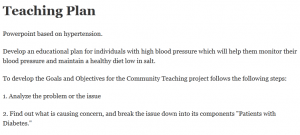Powerpoint based on hypertension.
Develop an educational plan for individuals with high blood pressure which will help them monitor their blood pressure and maintain a healthy diet low in salt.
To develop the Goals and Objectives for the Community Teaching project follows the following steps:
1. Analyze the problem or the issue
2. Find out what is causing concern, and break the issue down into its components “Patients with Diabetes.”
3. Identified the Stakeholders (‘key players’ or main stakeholders and invite them to be part of the project) “Talk to the Diabetes educator”
4. Know your target group (a group, for example, adolescents with Type I DM)
5. Understand the characteristics of your target group “recently diagnosed diabetes patient” “Pre-menopausal women at risk for diabetes.”
6. Determine the goals and objectives
7. Determine the result you want from your community education project. Define this in terms of a goal, educational objectives, and desired outcomes
8. The goal or aim of your project is a broad statement of what you want to achieve.
Objectives
Define your educational objectives in terms of the knowledge, skills, values, beliefs, and practices you want the target group to adopt to achieve the goal.
Educational objectives:
At the end of the project, participants will:
1. verbalize increased knowledge and understanding of the diabetes disease process.
2. be able to identify the signs and symptoms of hyper and hypoglycemia.
3. be able to identify solutions to the environmental impacts
4. develop an appreciation for glycemic diet and the importance of monitoring blood glucose.
5. use of the American Diabetes Association guidelines for blood glucose control.
Design your educational project (based on evidence)
1. Make an action plan and implement it
2. Evaluate the objectives by testing or surveying the knowledge and attitudes of the participants concerning the purposes.
Consider This:
SMART:
1. Specific: Clearly state the issue, the target group, the time and place of the activity.
2. Measurable: Be clear in the objective of what will be changed and by how much. Setting this clearly at the start makes it easier to evaluate: Example of a measurable goal “within the next six weeks, I will develop a health literacy program for at-risk of amputation diabetic patients in the community. I will survey at the end of the program, 80% of participants will answer at least five questions correctly in the survey.”
3. Achievable: Be realistic about what the project achieves in terms of the scale/scope of what is being done, time, and resources available.
4. Relevant: Objectives need to relate to and be relevant to the goals. Remember objectives are the building blocks/steps toward meeting the goals
5. Time Specific: Be clear in the objectives about the timeframe in which the program/activities, as well as expected changes, will take place
Remember that the rest of the course will be used to accomplish your goal by having a clear goal.
1. Goal statements “identify” the specific target group and provide the “what” information as distinct from the “how” the goal will be achieved or when it will come about.
2. Objectives are the building blocks or steps towards achieving a program’s goals. Objectives are specific and concise statements that state who will make what change, by how much, where, and by when.
Identifies the target group
States the result (change)
Specifies the degree of change in measurable terms (degree)
Identifies when the will happen (time)
